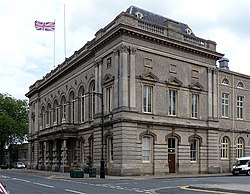
North East Lincolnshire is a unitary authority area with borough status in Lincolnshire, England. It borders the borough of North Lincolnshire and districts of West Lindsey and East Lindsey. The population of the district in the 2011 Census was 159,616. The administrative centre and largest settlement is Grimsby and the borough includes the towns of Cleethorpes and Immingham as well as the villages of New Waltham, Waltham, Humberston, Healing and Great Coates. The borough is also home to the Port of Grimsby and Port of Immingham as well as Cleethorpes beach.

Cleethorpes is a seaside town on the estuary of the Humber in North East Lincolnshire, England with a population of 38,372 in 2020. It has been permanently occupied since the 6th century, with fishing as its original industry, then developing into a resort in the 19th century. Before becoming a unified town, Cleethorpes was made up of the three small villages of Itterby, Oole and Thrunscoe.

Grimsby or Great Grimsby is a port town and the administrative centre of North East Lincolnshire, Lincolnshire, England. Grimsby adjoins the town of Cleethorpes directly to the south-east forming a conurbation. Grimsby is 45 mi (72 km) north-east of Lincoln, 33 mi (53 km) south-south-east of Hull, 28 mi (45 km) south-east of Scunthorpe, 50 mi (80 km) east of Doncaster and 80 mi (130 km) south-east of Leeds.

Scunthorpe is an industrial town in North Lincolnshire, in the ceremonial county of Lincolnshire, England. It is the county's third most populous settlement, after Lincoln and Grimsby. It is North Lincolnshire's most populous settlement.
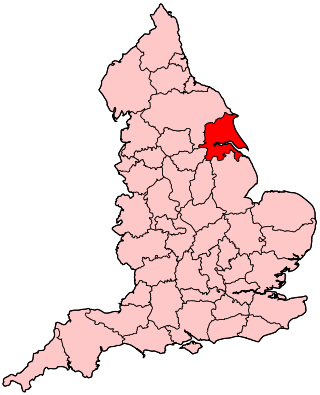
Humberside was a non-metropolitan and ceremonial county in Northern England from 1 April 1974 until 1 April 1996. It was composed of land from either side of the Humber Estuary, created from portions of the East Riding of Yorkshire, West Riding of Yorkshire, and the northern part of Lindsey, Lincolnshire. The county council's headquarters was County Hall at Beverley, inherited from East Riding County Council. Its largest settlement and only city was Kingston upon Hull. Other notable towns included Goole, Beverley, Scunthorpe, Grimsby, Cleethorpes and Bridlington. The county stretched from Wold Newton in its northern tip to a different Wold Newton at its most southern point.

Immingham is a town and civil parish in North East Lincolnshire, in Lincolnshire, England. It is situated on the south-west bank of the Humber Estuary, and is 6 miles (10 km) north-west from Grimsby.

Humberside Airport is an international airport at Kirmington in the Borough of North Lincolnshire, England, 10 NM from three large settlements: Grimsby (east), Hull (north) and Scunthorpe (west), on the A18, the latter two places reached by longer roads, in the case of Hull via England's longest bridge that crosses the Humber Estuary. It was owned by Manchester Airports Group from 1999 until 1 August 2012, when it was sold to the Eastern Group of companies. North Lincolnshire Council retains a minority of shares in the Airport.
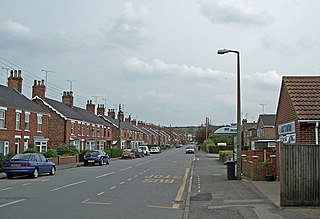
Barnetby le Wold is a village and civil parish in North Lincolnshire, Lincolnshire, England, located between Brigg and Immingham. The village is also near Barton-upon-Humber. The population of the parish in the 2001 census was 1,593. This increased by 148 to 1,741 in the 2011 census.
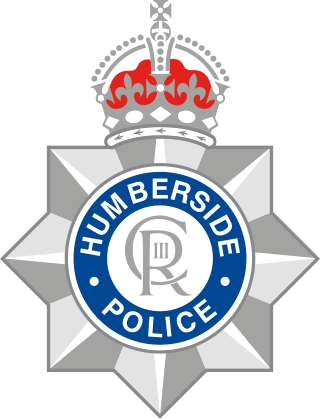
Humberside Police is the territorial police force responsible for policing The East Riding of Yorkshire including Hull and northern parts of Lincolnshire including Grimsby and Scunthorpe.
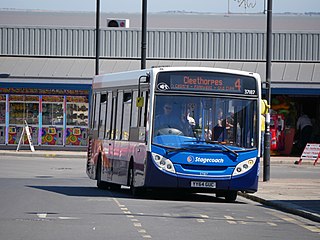
Stagecoach Grimsby-Cleethorpes is a subdivision of Stagecoach East Midlands that operates buses in and around North East Lincolnshire, England, serving a population of over 150,000. It runs town services in its main hubs of Grimsby and Cleethorpes, as well as services to Immingham and nearby villages.

Holton-le-Clay is a village and civil parish in the East Lindsey district of Lincolnshire, England, around 5 miles (8.0 km) south of Grimsby.

North East Lincolnshire Council is the local authority of North East Lincolnshire. It is a unitary authority, having the powers of a county council and district council combined. It was established on 1 April 1996 on the abolition of Humberside County Council, Great Grimsby Borough Council and Cleethorpes Borough Council. The council provides a full range of local government services including Council Tax billing, libraries, social services, processing planning applications, waste collection and disposal, and it is a local education authority.

Leigh Town Hall is a municipal building in Leigh, Greater Manchester, England. It stands in Civic Square at the junction with Market Street, facing Leigh parish church. It was built in 1907 and granted grade II listed building status in 1987.
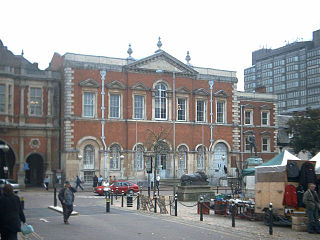
Aylesbury Crown Court, also known as Old County Hall, is a former judicial facility and municipal building in Market Square, Aylesbury, Buckinghamshire, completed in 1740. The building served as the meeting place of Buckinghamshire County Council from 1889 until 2012, and was used as a court until 2018. It is a Grade II* listed building.

The Old Town Hall, Richmond on Whittaker Avenue in Richmond, London is a former municipal building which from 1893 to 1965 served as the town hall for the Municipal Borough of Richmond.

Preston Town Hall is a municipal building in Lancaster Road in Preston, Lancashire, England. The town hall, which is the headquarters of Preston City Council, is a Grade II listed building.
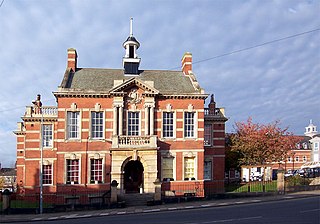
Cleethorpes Town Hall is a municipal structure in Knoll Street, Cleethorpes, Lincolnshire, England. The town hall, which was the headquarters of Cleethorpes Borough Council, is a Grade II listed building.
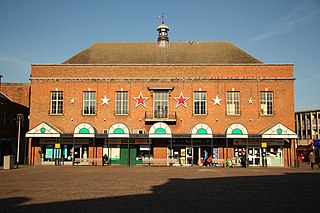
Gainsborough Town Hall is a municipal building in the Market Place in Gainsborough, Lincolnshire, England. The town hall was the headquarters of Gainsborough Urban District Council and now serves as a local entertainment venue.

Louth Town Hall is a municipal building in Eastgate in Louth, Lincolnshire, England. The structure, which was the meeting place of Louth Borough Council, is a Grade II listed building.

Grimsby Combined Court Centre is a Crown Court venue which deals with criminal cases, as well as a County Court venue, which deals with civil cases, in Town Hall Square, Grimsby, England.
